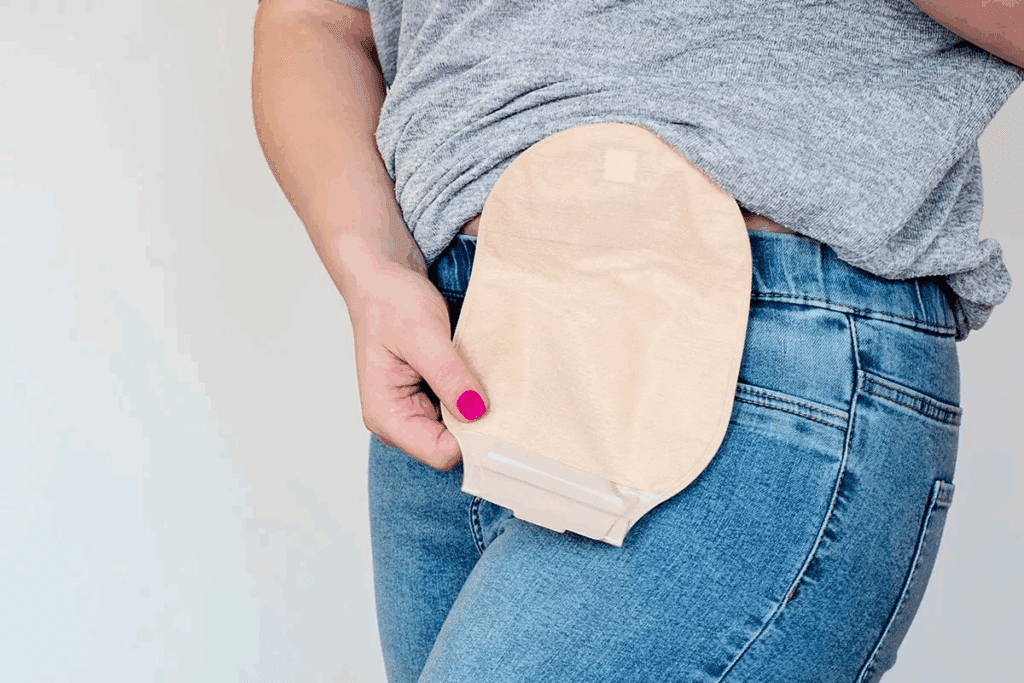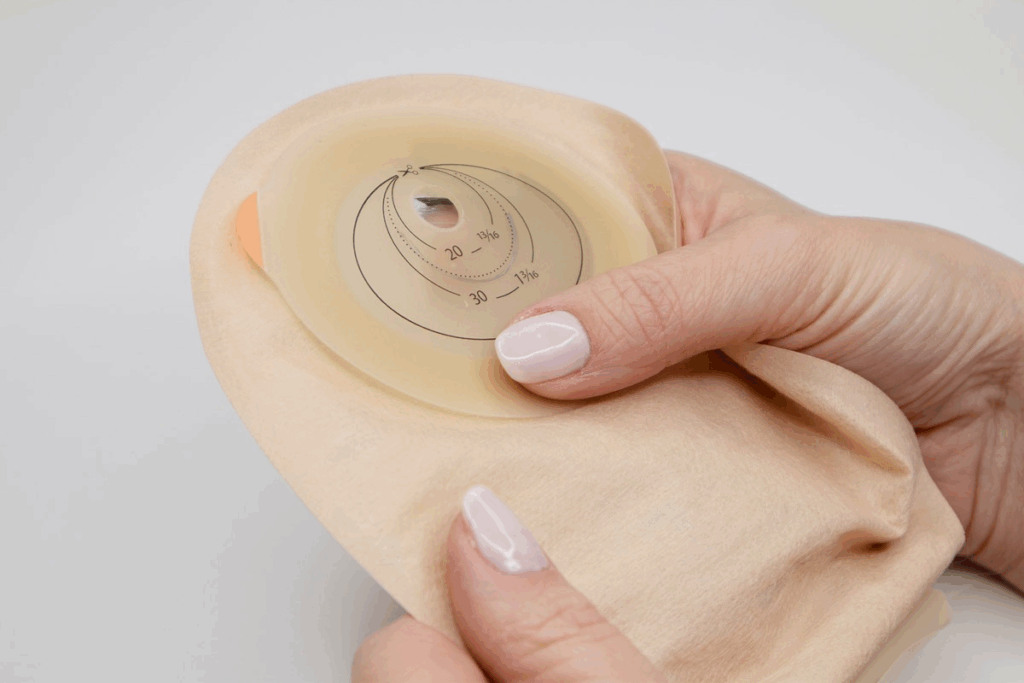Last Updated on November 26, 2025 by Bilal Hasdemir

For those facing ostomy surgery, knowing the terms and devices is key. A colostomy bag, also called a stoma or ostomy bag, is a small, waterproof pouch. It collects waste from the body through a surgically made opening in the belly.
Liv Hospital focuses on patient care, making it clear that understanding ostomy devices is important. These devices help manage waste well, making life better for those with a stoma.

Ostomy surgery creates a stoma in the abdomen to divert waste. It’s done for many health issues affecting the digestive or urinary systems.
An ostomy surgery makes a new opening in your body for waste. It involves moving a part of the intestine to the abdomen’s surface. This creates a stoma, where waste is collected in a pouch or bag.
The surgery starts with an incision in the abdomen. Then, the surgeon finds and moves the intestine to the surface. The type of ostomy depends on the medical condition and affected area.
Ostomy surgery is needed for several reasons, including:
Doctors choose ostomy when other treatments don’t work. It aims to restore normal functions and improve life quality.
| Condition | Description | Relation to Ostomy |
| Cancer | Malignant growth in the colon or rectum | Often requires removal of affected portion, potentially leading to ostomy |
| IBD | Chronic inflammation of the digestive tract | May necessitate ostomy if other treatments fail |
| Diverticulitis | Inflammation of diverticula in the colon | Can lead to ostomy in severe or complicated cases |
Knowing why someone has an ostomy is key for patients and caregivers. It helps manage expectations and adjust to life with an ostomy.

A colostomy bag is key for ostomy care. It keeps waste safe and clean. It’s for people who have had surgery to make an opening in their belly for waste.
A colostomy bag catches waste from the colon. It helps patients manage their health well. The bag has a pouch, an adhesive flange, and sometimes filters or valves.
Key components of a colostomy bag system:
Colostomy bags attach to the stoma, a surgically made opening. Waste from the colon goes into the pouch for collection and disposal.
The process involves:
Experts say modern colostomy bags have greatly improved life for those with ostomies. They offer discretion, comfort, and security.
“Ostomy care has come a long way, and the technology behind colostomy bags is continually evolving to meet patient needs.”
Colostomy bags are for both short-term and long-term needs. The type of ostomy depends on the medical condition and surgery.
| Characteristics | Temporary Colostomy | Permanent Colostomy |
| Purpose | Allows the colon to heal from surgery or disease | Provides a permanent solution for waste management due to severe colon damage or removal |
| Reversal Possibility | Often reversible once the underlying issue is resolved | Generally not reversible |
Knowing about colostomy bags is key for those with or considering an ostomy. Understanding how they work and the differences between temporary and permanent solutions helps manage the condition better. This improves life quality.
Ostomies come in three main types: colostomy, ileostomy, and urostomy. Each has its own surgery and purpose. Knowing the differences helps in caring for patients better.
A colostomy makes a new opening in the belly, called a stoma. It’s done when part of the colon is sick or needs to go. A special bag, called an ostomy bag, catches the waste from the stoma.
Key aspects of colostomy:
An ileostomy makes a new opening in the belly for the ileum, the small intestine’s end. It’s needed when the colon is gone or can’t work right.
Reasons for ileostomy:
A urostomy makes a new opening for urine to go out. It’s used when the bladder is gone or can’t work right.
“A urostomy provides an alternative route for urine to exit the body when the normal flow is disrupted.”
The table below shows the main differences between these ostomies:
| Type of Ostomy | Location | Function |
| Colostomy | Colon | Diverts fecal waste |
| Ileostomy | Ileum (small intestine) | Diverts fecal waste when colon is removed or bypassed |
| Urostomy | Urinary system | Diverts urine |
Knowing these differences helps patients and caregivers manage their conditions better. It improves their quality of life.
Colostomy bag technology has made big strides, leading to many different systems. These systems aim to make life easier for those with ostomies. They focus on comfort, security, and keeping things private.
There are mainly two types of colostomy bags: one-piece and two-piece. A one-piece system has the pouch and adhesive barrier in one. This makes it small and easy to put on. On the other hand, a two-piece system has the pouch and flange (adhesive barrier) separate. This lets users change the pouch without taking off the flange, which can be more comfortable for some.
Choosing between these systems depends on what you need and like. For example, someone with trouble using their hands might like a one-piece system. But, if you need to change your pouch often, a two-piece system might be better.
Colostomy bags also come in drainable or closed types. Drainable pouches have a bottom outlet for emptying. They’re good for people with a lot of liquid output. These pouches can be cleaned and reused, saving money and reducing waste.
Closed pouches are for those with solid output. They’re used once and then thrown away. The choice between drainable and closed pouches depends on how much liquid you have and what you prefer.
Today’s colostomy bags have special features to make life better. They include filters to reduce odors, materials that are soft and flexible, and secure closures. Some pouches even have built-in stoma covers or are made to fit with certain clothes. These features help users feel more confident and comfortable.
These new designs show a big effort to improve life for people with ostomies. By providing many options and features, makers help users find what works best for them.
Living with a colostomy bag requires some key practices for comfort and hygiene. It’s important to manage the bag well to live normally. Jane Doe, a ostomy patient, says, “Adjusting to life with a colostomy bag was tough, but learning the right ways helped a lot.”
Changing and emptying the colostomy bag are important tasks. They need careful attention to avoid problems. It’s key to be gentle with the stoma to prevent irritation.
A typical routine includes:
Good skin care around the stoma is vital to avoid irritation and infection. Using the right products and techniques can greatly improve comfort. A patient shared, “I was surprised at how much of a difference proper skin care made in my comfort level.”
Key practices include:
Managing odor and leakage is a big concern for those with a colostomy bag. The right products and techniques can help a lot. Activated charcoal filters and odor-neutralizing sprays are good solutions.
To manage leakage, it’s essential to:
“The key to managing a colostomy bag is being proactive and prepared. With the right mindset and tools, individuals can lead active and fulfilling lives.”
By following these guidelines and staying informed, individuals with a colostomy bag can face daily challenges with confidence.
Ostomy accessories and support products offer comfort, security, and confidence. They are key to managing an ostomy well. This improves life quality greatly.
Barriers, adhesives, and sealants are vital in ostomy care. They protect the skin and keep the ostomy bag in place. Barriers like skin barrier wafers prevent irritation and make pouch removal easy.
Adhesives secure the ostomy bag. They come in different types, like adhesive wafers and rings. These are gentle on the skin but strong. Sealants fill gaps around the stoma for a tight seal and prevent leaks.
Products like Stomipose boost comfort and confidence for ostomy patients. Stomipose is a supportive undergarment that keeps the ostomy bag secure. It reduces leakage risk and offers extra support. Other items, like belts and supportive garments, also help distribute the bag’s weight evenly.
Cleaning is key for ostomy care. Supplies like wipes, cleansers, and deodorants keep the bag and skin clean. They ensure the bag works well and stays hygienic.
In summary, many ostomy accessories and support products are available. Understanding these can help individuals manage their ostomy better. This leads to better comfort, security, and life quality.
For those with a colostomy bag, knowing medical terms is key. The world of ostomy care is filled with complex terms. Many are often mixed up or not understood.
Medical terms for colostomy bags and ostomy care are specific. It’s important to know these terms. This helps patients, caregivers, and doctors talk clearly.
Key Terms:
The term “colostomy bag” is often misspelled. Some common mistakes are “colostomy bagg,” “colostimy bag,” and “colostomy bagging.”
The right spelling is “colostomy bag.” Using the correct term ensures patients get the right info and care.
Many terms in ostomy care are confused with each other. Knowing the differences is key for good care and management.
| Term | Definition |
| Colostomy | A surgery that brings the colon to the abdomen’s surface, making a stoma. |
| Ileostomy | A procedure that brings the small intestine to the abdomen’s surface, making a stoma. |
| Urostomy | A surgical diversion that redirects urine from the kidneys to a stoma on the abdomen. |
Understanding these differences helps people manage their care better.
Ostomies are common in the United States, affecting many lives. It’s vital to study them to improve care and support. As more people live with ostomies, knowing the facts is key.
About 800,000 to 1 million people in the U.S. have an ostomy. This includes those with colostomies, ileostomies, and urostomies. Each type has its own set of challenges.
Here’s a look at how many people have each type of ostomy:
| Type of Ostomy | Estimated Number |
| Colostomy | 400,000 – 500,000 |
| Ileostomy | 200,000 – 300,000 |
| Urostomy | 100,000 – 200,000 |
Studies show that many people with ostomies adapt well. A study in the Journal of Wound, Ostomy, and Continence Nursing found that “ostomy patients reported a significant improvement in their quality of life after receiving proper care and support.”
“The psychological impact of an ostomy should not be underestimated. Support from healthcare professionals, family, and ostomy support groups plays a critical role in patient adaptation and overall well-being.”
Research highlights the importance of:
As ostomy statistics change, so does the research to help patients. Understanding ostomies helps healthcare providers support those affected.
Living with an ostomy means making changes and accepting them. With the right support and care, people can live normal and happy lives. It’s important to take good care of the colostomy bag for a smooth transition into daily life.
Understanding the colostomy bag’s role and the different care options is key. This way, people can feel in control and confident again. They can then enjoy their favorite activities without worry.
There are many resources and support groups for those with ostomies. Using these and staying up-to-date with new care options can make a big difference. It helps improve the experience with the colostomy bag and overall life quality.
A colostomy bag, also known as an ostomy pouch, is a medical device. It collects waste from the body. This is needed when someone has a colostomy, a surgery that makes an opening in the abdomen.
An ostomy is a surgery that makes an opening in the abdomen. It diverts waste or urine flow. There are different types, like colostomy, ileostomy, and urostomy.
A one-piece system has the pouch and adhesive skin barrier together. A two-piece system has a separate pouch and adhesive skin barrier. This can be changed independently.
To change your bag, follow good hygiene and technique. This prevents skin irritation and leakage. You’ll remove the old pouch, clean the stoma and skin, and apply a new pouch.
Common items include barriers, adhesives, and sealants for pouch security. There are also stomipose and comfort enhancers for better fit and comfort. Cleaning and maintenance supplies keep the stoma and pouch clean.
Use odor-reducing products and ensure a proper pouch fit. Follow a regular emptying and changing schedule. Deodorants or filters can also help reduce odor.
Stomipose is an ostomy accessory for comfort and support. It helps improve the pouch’s fit and security.
Yes, there are different types, like colostomy, ileostomy, and urostomy. Each has its own purpose and function.
Research shows about 800,000 to 1 million people in the U.S. live with an ostomy. This number is expected to grow due to an aging population and more medical conditions.
Adapting to life with an ostomy requires education, support, and practice. Learn about ostomy care, manage daily life, and connect with others who face similar challenges.
Subscribe to our e-newsletter to stay informed about the latest innovations in the world of health and exclusive offers!